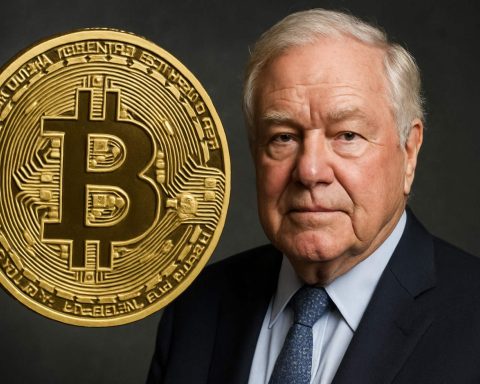- President Trump is exerting pressure on Federal Reserve Chairman Jerome Powell to cut interest rates, labeling Powell a “major loser” for resisting.
- This conflict emphasizes tensions between the White House and the Federal Reserve’s traditional independence.
- Pushing for rate cuts, Trump argues that lower energy and food costs contradict perceived inflation risks.
- Powell maintains that reducing rates could trigger inflation, prioritizing economic stability over presidential demands.
- Legal precedents protect the Fed chair from dismissal without misconduct, reflecting the balance of power in U.S. governance.
- Despite potential legal challenges, Trump remains determined to push Powell out if he doesn’t comply.
- The clash highlights the broader theme of checks and balances and the enduring strength of institutional autonomy.
- The outcome of this confrontation could significantly influence the future of American economic governance.
The sky above Washington, D.C. remains unsettled as President Donald Trump, with his relentless vigor, directs a torrent of his ire toward Federal Reserve Chairman Jerome Powell. Declaring Powell a “major loser,” Trump has intensified his drumbeat to slash interest rates, a move he sees as vital to breathing life into the American economy. His declaration, bold and unyielding, suggests potential dismissal unless Powell complies—a scenario that underscores the escalating tension between the White House and the traditionally independent Federal Reserve.
Trump’s narrative paints a picture of descending energy and food costs, contrasting this with a supposedly phantom inflation. His aim? To sway the Federal Reserve into making what he views as indispensable rate cuts. Yet, Powell stands defiant, anchoring the Fed’s steadfast stance that lowering rates amidst market uncertainty could unleash an inflationary surge—a risk with far-reaching repercussions.
The stage is set for a gripping economic duel, layered with constitutional intrigue. Legal safeguarding, stemming from a 90-year-old Supreme Court precedent, theoretically shields Powell from presidential dismissal barring misconduct. The Supreme Court’s 1935 ruling asserts a protective buffer for the Fed chair, guarding the sanctity of its independent operations—a principle enjoying bipartisan support across the hallowed halls of Congress.
Trump, known for his boundary-pushing leadership, remains unperturbed by these constraints. “If I want him out,” Trump proclaims with resolute bravado, “he’ll be out of there real fast.” The administration’s camp, spearheaded by Kevin Hassett of the National Economic Council, is allegedly probing creative avenues to preempt Powell’s term, set to conclude in 2026.
Yet, Powell remains undaunted. rooted in his duty to anchor inflation expectations. His resolve is more than personal; it’s institutional, implying that altering the course arbitrarily due to presidential pressure could shake the very foundation of economic stability—a pillar holding the nation’s fiscal steadiness.
The broader implication hints at the delicate dance of checks and balances intrinsic to American governance. Trump’s pursuit, emblematic of broader partisan frictions, evokes questions about how deeply the President might reshape this balance. Despite the storm, Powell, an appointee across administrations, appears committed to his mandate—ensuring a considered approach to economic stewardship amid pressure-laden skies.
The takeaway? An unwavering battle between White House pressure and Federal Reserve autonomy unfolds, suggesting that sometimes the most potent forces shaping a nation are neither presidents nor policies alone, but the institutions that uphold their respective missions. Amid this test of wills, Americans watch, as one president’s aggressive tactics collide with a defender of fiscal impartiality. The outcome could very well redefine the bounds of economic governance.
Trump vs. Federal Reserve: The Battle for Economic Control
A Deeper Dive into the Trump-Powell Tensions
The clash between President Donald Trump and Federal Reserve Chairman Jerome Powell underscores a crucial moment in American economic history, where presidential command confronts the traditionally independent central banking system. Here are some additional insights and context about this intricate economic engagement:
Historical Context of Federal Reserve Independence
– Precedents and Protections: The Federal Reserve was established in 1913 with the intention of keeping monetary policymaking separate from political influence. A key 1935 Supreme Court ruling provides legal protection to the Federal Reserve Chairman, allowing removal only for cause rather than policy disagreements. This ensures stability and confidence in the U.S. economic system.
– Comparative International Perspectives: Many other central banks around the world enjoy similar independence to avoid the short-term economic tinkering that can come with political cycles. This separation is intended to allow for more measured economic policies.
Economic Implications of Trump’s Desired Rate Cuts
– Potential Benefits: Proponents of Trump’s call for rate cuts suggest these could stimulate economic growth by making borrowing cheaper, thus encouraging spending and investment.
– Inflation Risks: On the flip side, Powell’s caution is rooted in the risk that lowering rates too soon or too aggressively could spark an inflationary wave. Historical instances have shown that unchecked inflation can erode purchasing power and destabilize economies.
How-to Steps: Understanding Monetary Policy Impact
1. Monitor Economic Indicators: Keep an eye on inflation rates, unemployment stats, and GDP growth as indicators of economic health.
2. Understand Interest Rate Impact: Recognize how rate changes affect your borrowing costs, savings rates, and overall economic activity.
3. Stay Informed on Federal Reserve Announcements: These can influence markets and impact your personal financial decisions.
Real-World Use Cases
– Businesses: Lower rates can reduce borrowing costs for capital investments, potentially boosting expansion plans.
– Consumers: Cheaper loans for homes and cars could increase spending capacity, though savings yields may decline.
Market Trends & Insights
– Global Economic Shifts: As other central banks also adjust interest rates, the global economic landscape is prone to shifts, affecting international trade and investments.
– Technological Influence: With fintech innovations, the way monetary policies are applied or perceived could transform, emphasizing transparency and real-time data.
Pros & Cons Overview
– Pros of Rate Cuts:
– Stimulates economic growth.
– Decreases unemployment short-term.
– Boosts stock markets temporarily.
– Cons of Rate Cuts:
– Risk of inflation.
– Long-term economic overheating.
– Diminished savings interest returns for consumers.
Actionable Recommendations
– Diversify Investments: To mitigate risks from interest rate changes, consider a diverse portfolio balancing stocks, bonds, and tangible assets.
– Stay Educated: Engaging with reliable financial news sources helps you anticipate shifts and adjust your strategies accordingly.
Key Links
To stay updated with authoritative insights, consider visiting the official site of the Federal Reserve.
In conclusion, as we observe the unfolding dynamics between Trump and Powell, it becomes vital for Americans and businesses alike to understand the broader economic implications and prepare accordingly. The balancing act of economic policy, influenced by political figures but stabilized by independent institutions, remains a cornerstone of American fiscal governance.

















